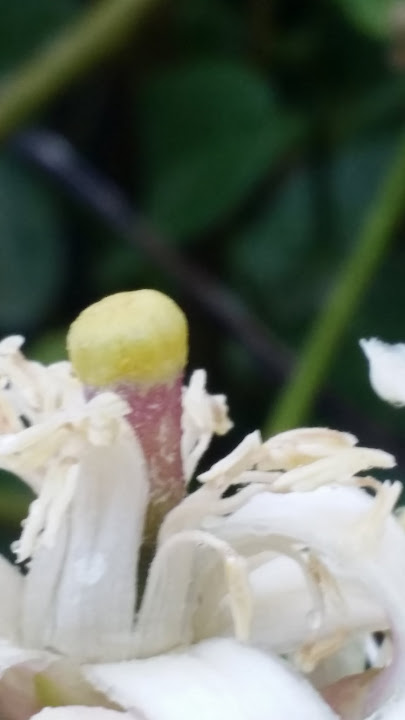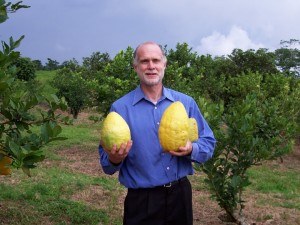Darrell Zaslow is not your run-of-the-mill attorney. In practice for 37 years, he is credited with seminal cases in the area of divorce and real estate law in the appellate courts, and is the author of several law texts on Real Estate and Municipal law. His prime extracurricular activity is the writing of works on Jewish history, and he was privileged to publish, “A Divine Madness”, the commentary on Rav Avigdor Miller’s manuscript on the Holocaust. Presently, he is preparing for publication, iy”H, a History of the Jews, which he has been writing for almost the same number of decades that he has devoted to one of his biggest passions in life–growing esrogim.

It all began because Darrell had the privilege of moving his elderly grandmother from Philadelphia to Atlantic City every summer. A major part of moving her in was planting her tomatoes and peppers. It was a mitzvah but also an agricultural education. From the time he finished law school in 1978, he and his wife, Sherri, had an urban patch of garden space of their own.
“About six weeks after the Succos holiday of 1992, I cut open my esrog–which by then was soft–and was overwhelmed by the beautiful citrus fragrance and the many dozen seeds inside,” recalls Darrell. “I germinated the seeds (layered between damp sheets of paper towel, with a plate above and below) and was amazed by the number of seeds which within a month began to sprout. From that day to this I have kept a journal of the progression of the esrog’s entire enterprise; the impetus for the journal was the practice of Thomas Jefferson, who meticulously recorded all of his orchard activities. The following season, after the chag when an esrog is proverbially worthless, I procured boxes of unused esrogim–well over 100–and removed all of the seeds, which numbered many thousands.”

All of Darrell’s original trees were started from seeds. In the years to follow, the trees have been created both by seeds and by the procedure of mavrich.
Darrell has seen every kind of esrog. In fact, he says, the same tree can grow fruit with a pitom and without a pitom, smooth and bumpy, beautifully shaped and oddly misshapen, fruit with a gartel and without a gartel, which just appears for no apparent reason.

“I never counted the number of trees or fruit produced,” notes Darrell. “I was soon bound up with the souls of the trees as to consider them almost as children, and refrained from numbering them. At the height of production I was caring for over 100 trees which produced fruit, anywhere from a few to a dozen per tree. The trees all being in pots, they were not as prolific as the pardasim in Israel or other places where the trees are grown in the good soil of the Holy Land.

“It is magnificent to observe the trees in growth, and to watch the trees bud with many flowers,” continues Darrell. “It is an incredible experience to see everything that the mesorah discusses growing before our eyes. For example, the esrog trees flower year-round. It is a sign that the tree is actually an esrog tree, and not chas v’shalom some grafted hybrid. An orange tree or grapefruit tree has a season of a few months. The orange tree flowers, and produces fruit, all at the same time. Anything not picked will fall off the tree. Not so the esrog, which blooms and fruits all year long; and the fruit will remain on the tree and grow larger year-to-year.”

Darrell contends that he has seen many thousands of fruits, and that most of them would not pass muster as acceptable fruit for use on the chag. “It is not easy to produce the perfect fruit. That contributes to its expense. For every thousand flowers there may be 100 fruits and from those hundred fruits there may be 20 that survive to adulthood, and of those 20 perhaps a mere few will qualify as beautiful enough for our use.”
What do the Zaslows do with all the esrogim they grow? They have never sold an esrog fruit. Rather, they leave all the fruit on the trees so that people can see how an esrog grows, and how beautiful the trees and flowers and fruit really are, in addition to learning all about it in front of their eyes, since it is difficult to understand, sometimes, from just reading it from a book. From time to time, they have sold small esrog plants to those eager to try their hand at it, in order to defray the enormous cost of heat, water, fertilizer, and other requirements.

What would one of Darrell’s esrog fruits cost, if he would decide to sell them? Darrell responds with a chuckle, “It would be like the cost of the tomatoes that I grow, but multiplied a hundred fold. By the time I bring a tomato to the table, accounting for the cost of good soil, insecticides, fertilizer, and everything that goes with it, plus my billable hourly rate as an attorney, each tomato probably costs about $25.”

One of the most interesting experiences that Darrell has had, with regard to his esrog pardes (orchard) passion, took place in the supermarket. “My attention in line was drawn to a little book for sale entitled, “Baby Names”,” recalls Darrell. “For whatever reason, I opened it, and was drawn to the page which actually had my name, and spelled as I spell it: D-A-R-R-E-L-L. The book said that Darrell means “grove of citrus trees”, in French. So HaShem runs the world, everything has meaning; I was privileged to mindlessly pick up a little book and be drawn to the page with something personally meaningful.

Concludes Darrell, “It is amazing to go out to the pardes a few hours before Succos and pick a fruit off the tree to use. What is most amazing is seeing Hashem’s creation living and growing before our eyes, and to see the complete and utter accuracy of everything brought down in the Mishna and Midrash about this beloved holiday and fruit.”
Courtesy of BALTIMORE JEWISH LIFE.
{Matzav.com Newscenter}













The shaila is, are these esrogim kosher to make a Bracha on, lichatchila?
#1, why not